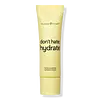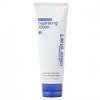Tarte Sugar Rush - Don't Hate, Hydrate Oil Free Moisturizer Versus Dermalogica Clear Start Skin Soothing Hydrating Lotion
What's inside
What's inside
 Key Ingredients
Key Ingredients

 Benefits
Benefits

 Concerns
Concerns

 Ingredients Side-by-side
Ingredients Side-by-side

Water
Skin ConditioningButylene Glycol
HumectantGlycerin
HumectantDimethicone/Vinyl Dimethicone Crosspolymer
Skin ConditioningDimethicone
EmollientHamamelis Virginiana Leaf Extract
Skin ConditioningPistacia Lentiscus Gum
MaskingNylon-12
Polysorbate 20
EmulsifyingPhenoxyethanol
PreservativeCarbomer
Emulsion StabilisingDimethicone Crosspolymer
Emulsion StabilisingHydroxyacetophenone
AntioxidantSodium Polyacrylate Starch
AbsorbentCaprylic/Capric Triglyceride
MaskingMethyl Trimethicone
Skin ConditioningSodium Hydroxide
BufferingHydrogenated Lecithin
EmulsifyingEthylhexylglycerin
Skin ConditioningSodium Hyaluronate
HumectantPhenethyl Alcohol
MaskingAroma
Saccharide Isomerate
HumectantSodium Carbonate
BufferingLimonene
PerfumingLinalool
PerfumingCitral
PerfumingPolyphosphorylcholine Glycol Acrylate
Geraniol
PerfumingCI 16035
Cosmetic ColorantWater, Butylene Glycol, Glycerin, Dimethicone/Vinyl Dimethicone Crosspolymer, Dimethicone, Hamamelis Virginiana Leaf Extract, Pistacia Lentiscus Gum, Nylon-12, Polysorbate 20, Phenoxyethanol, Carbomer, Dimethicone Crosspolymer, Hydroxyacetophenone, Sodium Polyacrylate Starch, Caprylic/Capric Triglyceride, Methyl Trimethicone, Sodium Hydroxide, Hydrogenated Lecithin, Ethylhexylglycerin, Sodium Hyaluronate, Phenethyl Alcohol, Aroma, Saccharide Isomerate, Sodium Carbonate, Limonene, Linalool, Citral, Polyphosphorylcholine Glycol Acrylate, Geraniol, CI 16035
Water
Skin ConditioningSqualane
EmollientButylene Glycol
HumectantC14-22 Alcohols
Emulsion StabilisingNaringenin
Skin ConditioningSalicylic Acid
MaskingSodium Hyaluronate
HumectantCitrus Grandis Peel Oil
MaskingZingiber Officinale Root Oil
MaskingCitrus Aurantium Dulcis Peel Oil
MaskingSaccharide Isomerate
HumectantGlyceryl Caprylate
EmollientTriethyl Citrate
MaskingC12-20 Alkyl Glucoside
EmulsifyingAcrylates/C10-30 Alkyl Acrylate Crosspolymer
Emulsion StabilisingPanthenyl Triacetate
Caprylhydroxamic Acid
Methylpropanediol
SolventAminomethyl Propanol
BufferingPolysorbate 20
EmulsifyingXanthan Gum
EmulsifyingBenzoic Acid
MaskingEthylhexylglycerin
Skin ConditioningCaprylic/Capric Triglyceride
MaskingCitric Acid
BufferingSodium Citrate
BufferingLimonene
PerfumingCitral
PerfumingPhenoxyethanol
PreservativeWater, Squalane, Butylene Glycol, C14-22 Alcohols, Naringenin, Salicylic Acid, Sodium Hyaluronate, Citrus Grandis Peel Oil, Zingiber Officinale Root Oil, Citrus Aurantium Dulcis Peel Oil, Saccharide Isomerate, Glyceryl Caprylate, Triethyl Citrate, C12-20 Alkyl Glucoside, Acrylates/C10-30 Alkyl Acrylate Crosspolymer, Panthenyl Triacetate, Caprylhydroxamic Acid, Methylpropanediol, Aminomethyl Propanol, Polysorbate 20, Xanthan Gum, Benzoic Acid, Ethylhexylglycerin, Caprylic/Capric Triglyceride, Citric Acid, Sodium Citrate, Limonene, Citral, Phenoxyethanol
Ingredients Explained
These ingredients are found in both products.
Ingredients higher up in an ingredient list are typically present in a larger amount.
Butylene Glycol (or BG) is used within cosmetic products for a few different reasons:
Overall, Butylene Glycol is a safe and well-rounded ingredient that works well with other ingredients.
Though this ingredient works well with most skin types, some people with sensitive skin may experience a reaction such as allergic rashes, closed comedones, or itchiness.
Learn more about Butylene GlycolThis ingredient is an emollient, solvent, and texture enhancer. It is considered a skin-softener by helping the skin prevent moisture loss.
It helps thicken a product's formula and makes it easier to spread by dissolving clumping compounds.
Caprylic Triglyceride is made by combining glycerin with coconut oil, forming a clear liquid.
While there is an assumption Caprylic Triglyceride can clog pores due to it being derived from coconut oil, there is no research supporting this.
Learn more about Caprylic/Capric TriglycerideCitral is a fragrance and used to add a lemon-like scent to products. It is both naturally found in plants and created synthetically. In plants, it is commonly occurring in lemon myrtle, lemongrass, lemon tea-tree, lemon verbena, and other citruses.
The EU mandates Citral be listed separately as a fragrance. It is a known allergen and may cause contact dermatitis. Citral can also used as a masking ingredient.
The term 'fragrance' is not regulated in many countries. In many cases, it is up to the brand to define this term. For instance, many brands choose to label themselves as "fragrance-free" because they are not using synthetic fragrances. However, their products may still contain ingredients such as essential oils that are considered a fragrance.
The term 'citral' is a collective term for two geometric isomers: geranial/Citral A and neral/Citral B.
Learn more about CitralEthylhexylglycerin (we can't pronounce this either) is commonly used as a preservative and skin softener. It is derived from glyceryl.
You might see Ethylhexylglycerin often paired with other preservatives such as phenoxyethanol. Ethylhexylglycerin has been found to increase the effectiveness of these other preservatives.
Limonene is a fragrance that adds scent and taste to a formulation.
It's found in the peel oil of citrus fruits and other plants such as lavender and eucalyptus. The scent of limonene is generally described as "sweet citrus".
Limonene acts as an antioxidant, meaning it helps neutralize free radicals.
When exposed to air, oxidized limonene may sensitize the skin. Because of this, limonene is often avoided by people with sensitive skin.
The term 'fragrance' is not regulated in many countries. In many cases, it is up to the brand to define this term. For instance, many brands choose to label themselves as "fragrance-free" because they are not using synthetic fragrances. However, their products may still contain ingredients such as essential oils that are considered a fragrance.
Learn more about LimonenePhenoxyethanol is a preservative that has germicide, antimicrobial, and aromatic properties. Studies show that phenoxyethanol can prevent microbial growth. By itself, it has a scent that is similar to that of a rose.
It's often used in formulations along with Caprylyl Glycol to preserve the shelf life of products.
Polysorbate 20 is made by combining ethoxylation of sorbitan, ethylene oxide, and lauric acid. It is a mild cleansing agent, surfactant, and emulsifier.
As a surfactant, it helps collect dirt and oils for washing. Emulsifiers prevent oils and water from separating.
Polysorbate 20 also adds scent to a product. Since it is made using sorbitol, it has a sweet scent. Sorbitol can also be found in fruits such as apples and peaches.
The lauric acid used to create Polysorbate 20 is often derived from coconuts.
Polysorbate 20 may not be fungal acne safe.
Learn more about Polysorbate 20Saccharide Isomerate comes from sugars found in corn. It is a skin hydrator.
The structure of this ingredient can be altered to be more similar to the carbohydrates found in our skin. This ability to mimic our skin gives it hydrating properties.
Specifically, saccharide Isomerate is a humectant. Humectants draw moisture from the air to our skin.
Research shows Saccharide Isomerate to be an effective moisturizer.
Learn more about Saccharide IsomerateSodium Hyaluronate is hyaluronic acid's salt form. It is commonly derived from the sodium salt of hyaluronic acid.
Like hyaluronic acid, it is great at holding water and acts as a humectant. This makes it a great skin hydrating ingredient.
Sodium Hyaluronate is naturally occurring in our bodies and is mostly found in eye fluid and joints.
These are some other common types of Hyaluronic Acid:
Learn more about Sodium HyaluronateWater. It's the most common cosmetic ingredient of all. You'll usually see it at the top of ingredient lists, meaning that it makes up the largest part of the product.
So why is it so popular? Water most often acts as a solvent - this means that it helps dissolve other ingredients into the formulation.
You'll also recognize water as that liquid we all need to stay alive. If you see this, drink a glass of water. Stay hydrated!
Learn more about Water